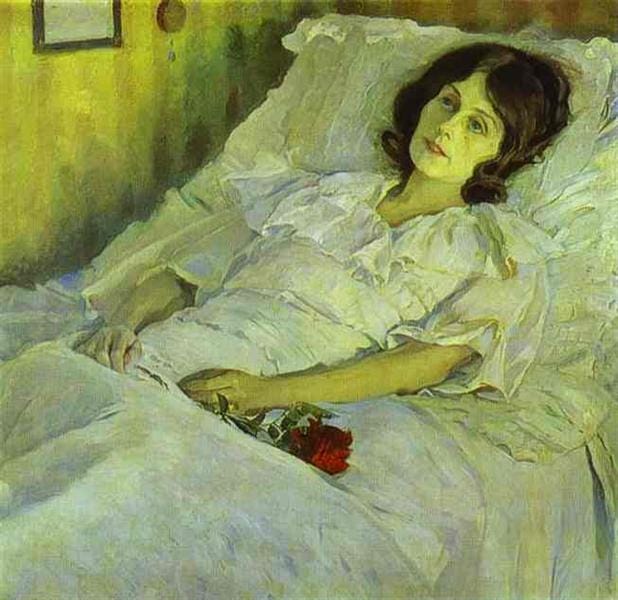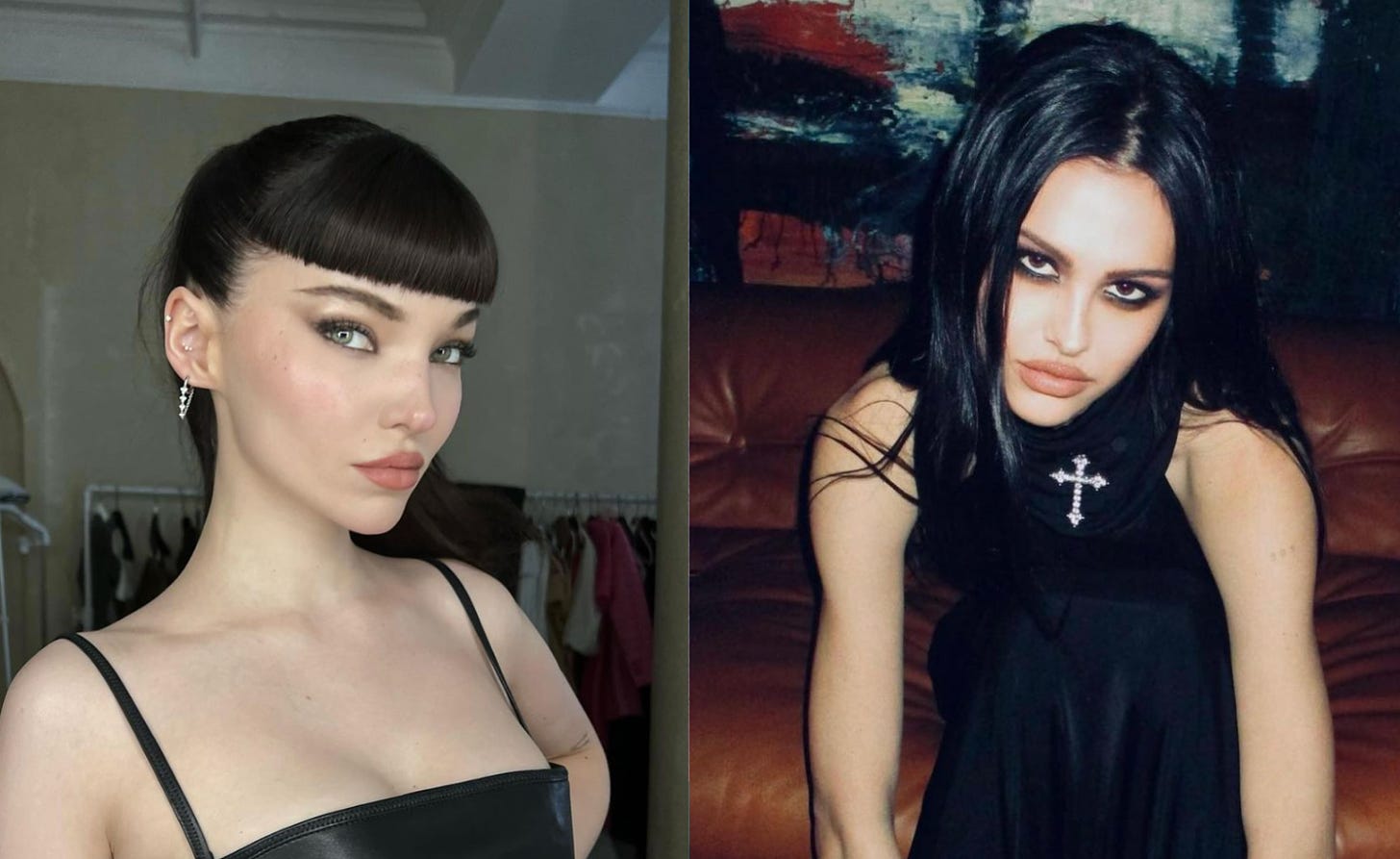It’s Hot To Look Ill
How sickness informs the standard of beauty, from tuberculosis to "dark bimbo."
The beauty industry is sick. See: consumption as a beauty ideal in the 1840s, malnourishment as a beauty ideal in the 1990s, and the “dark bimbo” or “succubus chic” look today — cheeks pinched courtesy of fat-sucking surgery, bones protruding courtesy of Ozempic injections, expression embalmed courtesy of neurotoxin-infused needles. “It may seem like the trend … is the same ‘heroin chic’ from the ’90s, but it’s actually something much more covertly sinister,” Laura Pitcher writes in a new article for Nylon. It’s “the latest in a long line of examples where the western beauty industry has pushed the idea that looking sick is apparently, well, hot.”
I was pumped when Pitcher asked to interview me for her piece — please read it here! — and I wanted to share some answers that didn’t make the final edit. Scroll for my thoughts on how “heroin chic” shape-shifted to survive the wellness era, why beauty culture glamorizes the aesthetic of illness (even as it perpetuates ableism), and the link between tuberculosis and cosmetic class performance.
NYLON: Beauty has glamorized certain sicknesses (thinking tuberculosis) throughout history. What do you think is the fascination between the two?
Jessica DeFino (me): Tuberculosis ended up influencing beauty standards for a few reasons that still endure today. One, the illness was thought to be hereditary and eventually was associated with the upper classes. As Susan Sontag writes in Illness as Metaphor, “The tubercular look had to be considered attractive once it came to be considered a mark of distinction, of breeding.” And what is modern “beauty” but a class performance?
Two, the air of illness reinforced traditional feminine gender roles. Looking sick meant looking vulnerable, sensitive, weak, and easily controlled — all “attractive” qualities for a woman to have in the capitalist patriarchy. We see this today, too. The “crying makeup” trend comes to mind as one obvious example. But also, I think it’s important to view the extreme level of aesthetic manipulation that adhering to today’s Western beauty standard demands through this lens. Even if some of the trends themselves seem to reject traditional femininity on the surface — like bleached eyebrows, or the whole “succubus chic” thing — the associated behaviors reinforce the ultimate feminine gender role: full submission to a culturally-conditioned ideal.
Three, there’s a spiritual element to illness, and beauty and spirituality have always been intertwined. Being sick, especially in the time of TB, meant being closer to death, presumably more conscious, and therefore more spiritually compelling. Copying the physical signs of TB was one of the first ways the body was recast as the self in beauty — as if making yourself look closer to the spirit world actually brought you closer to the spirit world. I think we see this reflected today in the whole beauty-as-wellness or skincare-as-self-care movements, where aesthetically manipulating the body is messaged as some deeper act of self-care, self-love, self-expression. (And even though “beauty-as-wellness” sounds like the opposite of romanticizing sickness, it actually assumes an imagined starting point of sickness — like, because we are “sick,” we must work toward being “well.”) The spirituality-beauty crossover in terms like “miracle product” and “Holy Grail” come to mind too.
I do think it’s important here to note that even as the beauty industry glamorizes the aesthetic of illness, it’s still deeply ableist. “Illness” is only considered cool if it’s put-on. It’s only considered “beautiful” or “chic” if it seems deliberate, if it signals wealth, if it demands money and effort. I’m thinking, for instance, of today’s bald brow trend. I am someone who currently has no eyebrows courtesy of an illness (trichotillomania). My mother has sparse eyebrows after going through chemo. The beauty industry does not consider our symptoms to be cool or beautiful or “alien-like” or edgy, which is how it frames “glamorized” bald brows. The beauty media does not see us as trend-setters. It sees us as sick, and sees that sickness as an opportunity to sell us pencils, powders, and procedures to make us look “well” again.
NYLON: We saw the era of “heroin chic” glamorizing drug addiction/anorexia and now that Dazed piece (controversially) called this moment the time of “succubus chic.” What are you seeing at the moment that's contributing to this?
JD: The through-line here is addiction. If “heroin chic” glamorizes drug addiction, “succubus chic” glamorizes cosmetic addiction. This is a look that’s unachievable without a considerable number of invasive and/or noninvasive procedures, many of which have to be repeated at three- to six-month intervals. Some studies have categorized repeated and compulsive cosmetic procedure use as a “substance abuse disorder.” Anecdotally, I do see similarities in the ubiquity of alcohol use and cosmetic procedure use in society more and more — maybe the majority of users aren’t “addicted” to either in the technical sense, but collectively, we are consuming these substances in concerning amounts. It makes sense; both are coping mechanisms to “help” us feel more comfortable in a world that 1) stifles the self (making us feel unsafe to show up as ourselves, in our bodies as-is) and 2) encourages consumption at all costs.
IF ‘HEROIN CHIC’ GLAMORIZES DRUG ADDICTION, SUCCUBUS CHIC GLAMORIZES COSMETIC ADDICTION.
NYLON: What do you think “succubus chic” is glamorizing?
JD: See above. But also! I think the “succubus chic” look — which I've also seen referred to as “dark bimbo” — is glamorizing the artifice of rebellion (that darker, goth-inspired look that seems to push back against the feminine beauty ideal) curated via the actions of conforming and consuming (so… the ultimate feminine beauty ideal!!!). It glamorizes an aesthetic that signals wealth, accumulation, excessive product use, and the general funneling of money into your face. It glamorizes submission to the beauty industry under the guise of independence and individuality. It’s performative pushback, especially when referred to as “dark bimbo.” (From what I’ve seen, the reclamation of “bimbo” by cisgender women essentially means using your words to promote the values of the political left while using your aesthetics to promote the excess of capitalism.)
NYLON: I'm really interested in how this desire to look “sick” fits into our current wellness culture climate and curated “messiness.” Where Kate Moss used to go clubbing all night and eat very little, models today are getting buccal fat removal and drinking Kin Euphorics for the same “look” but with the illusion of wellness still encoded. What do you think about this weird mashup?
JD: I don't necessarily think this is anything new. Thinness has been a beauty ideal for a long time and in many ways, extreme thinness is just sickness masquerading as health and wellness (especially in the medical system).
But I do think it marks a change in the way we, collectively, have taken to aestheticizing life instead of actually living it. In your example, Kate Moss was clubbing and doing drugs and starving herself. These actions led to a messy, thin aesthetic. Today, aesthetic comes first. The current cultural beauty ideal is one that signals wealth and wellness, and we signal that aesthetically with actions that actually decrease our wealth and wellness. (Surgical procedures like buccal fat removal siphon our money, an increasingly inhuman beauty ideal is associated with higher instances of appearance-related anxiety, depression, dysmorphia, and more.) Our actions are at odds with our aesthetics. We look “well” but are deeply unwell. All surface, no substance.
I think today’s beauty ideal of shiny, tight, glowing skin is a great example of this. The industry holds this up as the aesthetic of health, but it’s the opposite. Shiny, tight, reflective, non-responsive skin is not healthy. It’s damaged (as I’ve reported on in the past). This is just a glamorized health issue that prioritizes the aesthetic of healthy skin over the reality of healthy skin.
Our actions are at odds with our aesthetics. We look “well” but are deeply unwell.
NYLON: How can the beauty industry abandon these sickness-encoded trends altogether?
JD: I don't know that the beauty industry can abandon this altogether, because the industry survives on a model of sickness: constant growth, like a cancer. People can abandon these sickness-encoded trends by divesting from industrialized beauty.






I was listening to a podcast recently where they talked about the status symbol of having a sickly wife in the Victorian era, for the upper classes, anyway. It was seen as underlining the husband's virility that he could be the sole support for his entire family (and presumably, staff/household), and it was conversely emasculating for a woman to be healthy and vital. It's so creepy to me to think that women's basic health is read as having anything at all to do with masculinity.
Yes! In my book I talk about how, when I was 7 or 8 (in the 70s), girls around me started humble-bragging about their doctors diagnosing them as "underweight," a problem they just "couldn't help" but clearly starved themselves to perpetuate.